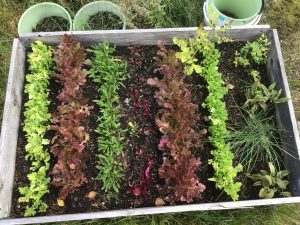Viljelylaatikkotutkimus

Turun kaupungin viljelylaatikkoprojekti alkoi 2016, ja vuosi vuodelta sen suosio on kasvanut ja laatikoita on jaettu kaupunkilaisille lisää. Laatikkoviljelijäryhmiä on noin 300 ja laatikoita on yli 700 joka puolella Turkua. Viljelijät voivat valita viljelylaatikkonsa sijainnin eli mihin kaupunki sen toimittaa, kunhan se sijaitsee kaupungin omistamalla maalla. Näin ollen toimintaan liittyy pieni riski, mutta silti yhä useammat viljelijät näkevät toiminnan houkuttelevaksi ja kannattavaksi eri tavoin. Julkinen sijainti myös tekee laatikot erityisen kiinnostaviksi yhteisten, avointen luonnonvarojen hallinnan näkökulmasta, sekä esimerkkinä urbaanista yhteisomistajuudesta (urban commoning).
Tutkimme Turun kaupungin tarjoamia kaupunkiviljelylaatikoita pienenä luonnonvarana, joka on vapaasti saatavilla kaikille kaupunkilaisille (www.turku.fi/laatikkoviljely). Urbaani yhteisöllisyys ja tietynlainen kaupunkiympäristön haltuunottaminen ovat tärkeässä osassa tällaista toimintaa. Yhteisöt, joita luodaan pienten paikallisten luonnonvarojen ympärille ovat mielenkiintoinen keino tutkia ihmisten kanssakäymistä ja ryhmissä luotuja epävirallisia sääntöjä ja toimintatapoja. Viljelylaatikot saattavat myös olla mielenkiintoinen poikkeus luonnonvarojen hallinnassa, joissa yhteistyö perustuu muihin toimintaperiaatteisiin kuin sääntöihin ja sanktioihin (Ostrom 2005). Viljelijät ovat valinneet toimia muun kaupungin kanssa yhteistyössä ja luoda monimuotoisuutta ja kauneutta lähiympäristöön saaden samalla itselleen tuoreita vihanneksia ja iloista mieltä.
Laatikoissa viljellään kukkia, kasviksia, yrttejä ja jopa sieniä. Laatikkoviljelyyn ryhdytään, jotta saataisiin tuoreita ja paikallisesti kasvatettuja kasviksia ja jopa säästettäisiin hieman kuluissa kasvattamalla itse ruokaa kesän aikana. Joillekin tärkein syy laatikkoviljelyyn voi olla ajan viettäminen naapureiden, lasten tai ystävien kanssa, naapuruston viihtyvyyden parantaminen tai yhteisöllisyyden tunteen lisääminen naapurustossa. Laatikkoviljely tarjoaa myös ulkoilmassa reippailua, vähentää stressiä ja tarjoaa henkistä virkistäytymistä ja rentoutumista. Haluamme tietää keitä laatikkoviljelijät ovat, miksi ihmiset haluavat osallistua laatikkoviljelyyn ja millä tavalla viljelyksiä hoidetaan. Tutkimuksen tavoitteena on myös tutkia milloin ja miksi toiminnassa onnistutaan, mitä tämä onnistuminen edes eri ihmisille on ja saavutetaanko toiminnalle asetetut odotukset ja tavoitteet. Vuonna 2020 ja 2021 olemme lisäksi kiinnostuneita kuinka globaalisti levinnyt korona-pandemia vaikuttaa viljelytoimintaan ja viljelijöiden asenteisiin.
Aineiston keräys
Kesän 2019, 2020 ja 2021 aikana kierrämme tutkimassa viljelylaatikoita selvittääksemme mitä ihmiset viljelevät, miten viljelykset onnistuvat ja millaisilla alueilla laatikot sijaitsevat. Lisäksi lähetämme kyselyitä viljelijöille kerätäksemme lisätietoa heistä ja heidän toiminnastaan. Viljelykauden alussa kysymme viljelijöiltä heidän viljelyryhmästään, suunnitelluista viljelyksistä ja odotuksistaan kesälle. Kesän lopussa teemme toisen kyselyn, joka keskittyy eri ryhmien välisiin eroihin ja millä tavoin eri viljelyryhmät eroavat viljelylaatikoista saadun taloudellisen tai sosiaalisen hyvinvoinnin osalta.
About the garden box study
There are garden boxes now scattered all over Turku, with more than 700 boxes managed by over 300 different groups or individuals. The city of Turku’s garden box project began in 2016 and is growing in popularity, with many new boxes added every year and the number of applicants this year far outweighing the number of boxes available.
We are studying urban garden boxes offered by the city of Turku as a small natural resource system, which is freely available for all citizens (www.turku.fi/laatikkoviljely). Common property systems are rare in urban ecosystems, but when people connect with green areas in cities it often increases their well-being and the potential for effective collective action (Andersson et al. 2014). The informal institutions and communities created around the local natural resource systems are an interesting way to study human interaction and informal rules and sanctions created in groups. However, the garden box system might be an interesting exception where the cooperation is based on other principles than rules and sanctions (Ostrom 2005).
The boxes are used to plant flowers, vegetables, mushrooms and herbs, and are managed mostly by self-organized groups. People may use garden boxes as a way to get fresh, locally sourced produce, and for the economic benefits over the summer through savings made on food purchases. For others, the key benefit may be the time that they will spend with their neighbors, children, or friends on their box project during the summer, or a sense of helping to improve the local community, by adding character or beauty to the park or to give a more communal feeling to a city by choosing to garden in an open area. As a solo activity gardening offers physical exercise and could help to reduce stress and improve mental well-being. We are interested in why people choose to use these garden boxes in Turku, how they manage their boxes, and how well it works in practice. The aim of the study is to find out how and when the governance of urban garden boxes as a natural resource system works, and how it differs between the groups. Surveys are being used to gather information on the key variables that could explain well-functioning cooperation and governance in order to shed light on which factors influence the governance of urban garden boxes.
A group can choose the location of the boxes but they must be placed on land owned by the city, rather than on private land. Thus, it is almost impossible to prevent those who visit the public area from exploiting or damaging the resource, should they have the will to do so. This openness and inability to protect the crop make the boxes interesting to study as an open urban natural resource.
Data collection
During summer 2019, 2020 and 2021 we are evaluating the boxes to collect data on the types of plants (or fungi) grown, and requesting box owners to fill out surveys to gather information on how they manage their boxes. At the beginning of the gardening season, we are asking box owners to complete a survey about their group, their planned cultivation, and expectations. At the end of the summer, a second survey will focus on comparing the attributes of the different groups, and how these factors connect to any economic or social well-being gained by the group members from their garden box projects.

Recent Comments